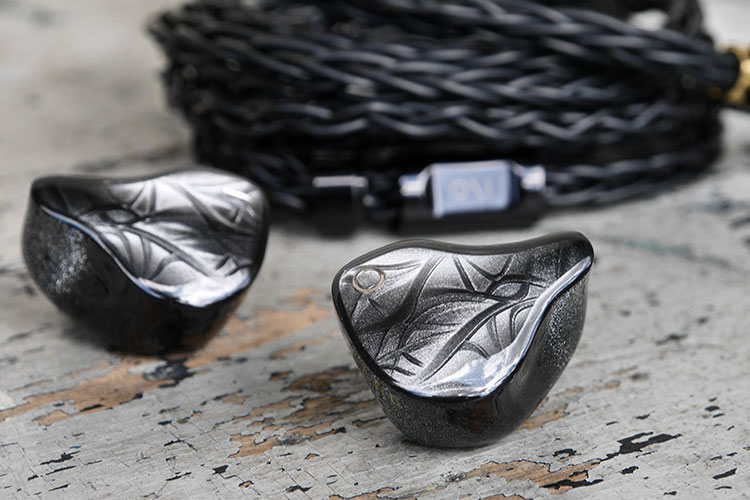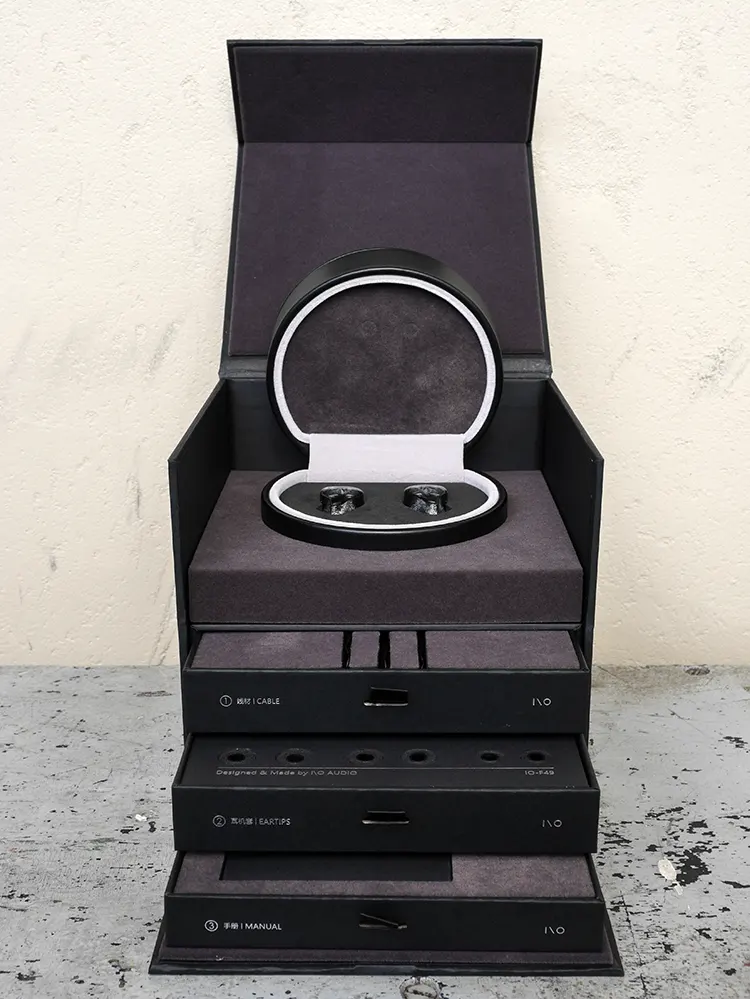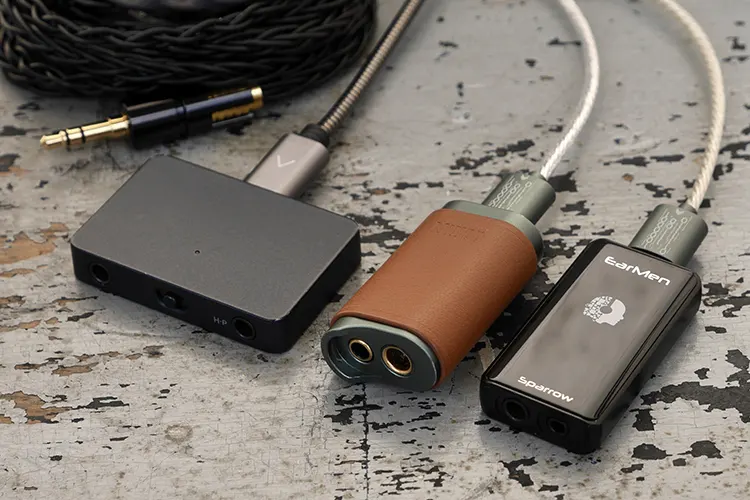Sound Impressions
The following sound impressions of the I/O AUDIo VOLARE were complete using a mix of the ddHiFi TC44C, the Earmen Sparrow, and the Earstudio HUD100 dongle DACs for both source and amplification.
Summary
With the VOLARE, I/O Audio has crafted an extremely versatile, jack-of-all-trades AND master-of-all earphone that entertains and impresses thanks to a bouncy, bright signature that is also technically adept.
The VOLARE’s sound has a noticeable sub-bass bias, prominent upper mids, and a sparkly brilliance region. The way it is tuned, no single aspect of the signature stands out too much or feels lacking.
The three driver types are also integrated brilliantly, giving the VOLARE a level of coherence I haven’t heard before in a product using three driver technologies. It is one of the few earphones I’ve come across that is good at everything, with one minor flaw.
Bass
I like to think the rubber and wood material combination of the VOLARE’s dynamic is evident. It is characterized by a warm, organic output that oozes quality on every bassline.
There is a clear bias towards sub-bass, with just the right presence across the rest of the bass region. It makes the presentation warm and thick in a realistic, not artificial way.
The extension is stellar, with the VOLARE providing a convincing visceral rumble on the deepest notes. While texturing is a definite weak point (that’s the rubber), and my only complaint about any aspect of the overall signature, everything else makes up for it.
Notes hit hard with a snappy decay that ensures rapid basslines retain their individual note definition. They don’t smear or blend into each other, which are characteristics that carry through the rest of the signature.
Mids
The VOLARE’s midrange plays out through a combination of the dynamic driver and armatures, which works brilliantly. While the mids peak around 3k, it’s not enough of a hump to make the presentation even remotely unnatural or fatiguing.
Vocals have a weightiness and bravado that keeps them prominent and at the forefront. The restrained lower mids help keep details crisp and clear without any sign of mud or lack of clarity.
Where the low-end lacks texture, the mids do not. Gruff sounds are appropriately layered, breathy vocals are spacious and subtle, and more defined instruments and voices come across as sweet or sinister as intended.
The VOLARE’s midrange does everything well with no glaring weaknesses. It even takes the edge off overly hot or sibilant tracks, making them more listenable than they would be through most other earphones or headphones.
Treble
Heading into the upper ranges I can see the VOLARE’s brilliance region peaks being a problem for more treble-sensitive listeners. For everyone else, you’ll experience a well-extended, tight, quick, sparkly, high-energy upper range that doesn’t fatigue the ears.
Notes are extremely well-defined with a complete lack of splash or slop. Attacks are impactful and notes decay and fade naturally. The electrostatic drivers have zero issues handling congestion, handily keeping individual track elements separate.
The presentation is also very smooth and refined. There is a complete lack of any harshness that would negatively impact the quality.
The VOLARE isn’t tuned like a traditional analytic earphone, but you can treat it as one thanks to the impressive technical performance on tap.
Staging & Dynamics
Staging on the VOLARE is, who would have guessed, outstanding. It has a well-above-average overall size with an even and immersive roundedness.
The default vocal positioning is just outside the inner ear, with effects launching well off into the distance. It has been a while since I used an earphone that made me so frequently pull them out thinking I heard something or someone in the room with me.
This cavernous sound stage is backed by technical chops that rival or surpass significantly more expensive products. Channel-to-channel movement is pinpoint accurate, tracks are perfectly layered, and instruments and effects are properly separated.
These qualities make the VOLARE a killer gaming earphone since you can pick out and track every little noise in your vicinity. With appropriately good sound design, every effect plays in a distinct field and can be focused on through the VOLARE.
Synergy
Efficiency & Sensitivity
The VOLARE has a sensitivity of 121 dB/Vrms @ 1 kHz and an impedance of 4.8Ω +/- 10% @ 1 kHz.
This earphone is impressively flexible with the sources you can use. Everything I’ve tried can bring it to comfortable listening volumes with ease, with the same being achieved for listening at overly low volumes.
Given the high sensitivity and low impedance, assuming the VOLARE would be source-sensitive is reasonable, but that’s not the case. I tested across various sources and the only one that produced any background hiss was the Earstudio HUD100.
Hiss was present only through the High Output port which is not designed for a product like the VOLARE. While it could be masked with music, using this port with the VOLARE was pointless since a flawlessly performing port was available a couple of centimeters to the left.
The VOLARE is not only efficient but forgiving of the source in play.
Pairings
To ensure I could use all three plugs included with the VOLARE, the ddHiFi TC44C, Earmen Sparrow, and Earstudio HUD100 were used for testing.
ddHiFi’s TC44C compliments the VOLARE wonderfully. With 3.5mm single-ended and 4.4mm balanced outputs, you can run the VOLARE however you prefer.
Volume output isn’t an issue with either port, with the VOLARE able to hit very low or uncomfortably high volumes. The TC44C’s refined signature doesn’t add sibilance, restrict extension in either direction, add some splash to the treble, or do anything else to hinder the VOLARE’s impressive performance.
Add a dead-quiet background to all those other benefits, and the TC44C is a near-perfect companion to accompany the VOLARE.
Analyzing the VOLARE’s sound output from the Sparrow revealed a hint of splash and harshness where there was normally none. While lessened through the single-ended output, it was still enough to remove the Sparrow from the rotation.
Finally, we have the Earstudio HUD100. Though it lacks any form of balanced output, a high-potency port intended for 250+ Ohm headphones is available.
As could easily have been predicted, the “H-P” port was not a good fit for the VOLARE. Hiss was intrusive, hindering the experience, even if it could be masked.
Through the standard port, the HUD100 felt right at home alongside the VOLARE. There is plenty of volume leeway, the VOLARE’s signature was maintained, and the staging was still outstanding.
Also, if you decided to modify the tuning, you could do so through the HUD100’s three sound modes.




